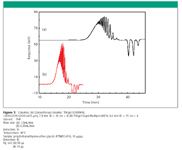Semi-Micro Columns for Size-Exclusion Chromatography in Organic Solvent Systems: TSK-GEL SuperMultiporeHZ Series Columns
The Application Notebook
In size exclusion chromatography, obtaining calibration curves over a wide range of molecular weights is a difficulty investigators often encounter when analyzing polymers with a broad molar mass distribution. To overcome this problem two procedures are typically used. One option is to use multiple columns of different pore sizes linked together in series. A second is to use a column packed with a mixed bed resin of different pore sizes at an optimized mix ratio. However, problems can occur with both of these methods, which include distortion of the chromatogram or deviations between the actual calibration curve and the calibration curve approximated from data obtained from the molecular weight standards.
Xavier Villarreal, Ph.D., Tosoh Bioscience LLC
In size exclusion chromatography, obtaining calibration curves over a wide range of molecular weights is a difficulty investigators often encounter when analyzing polymers with a broad molar mass distribution. To overcome this problem two procedures are typically used. One option is to use multiple columns of different pore sizes linked together in series. A second is to use a column packed with a mixed bed resin of different pore sizes at an optimized mix ratio. However, problems can occur with both of these methods, which include distortion of the chromatogram or deviations between the actual calibration curve and the calibration curve approximated from data obtained from the molecular weight standards.

Figure 1
As is shown in Figure 1, a novel approach to solve this problem was developed by Tosoh scientists and is incorporated in TSK-GEL SuperMultiporeHZ Series columns. Using proprietary multi-pore particle synthesis technology, packing material composed of monodisperse particles are synthesized in which a wide range of pore sizes are contained within a single particle. The TSK-GEL SuperMultiporeHZ Series product line further improves performance by reducing column dimensions to the semi-micro level (4.6mm ID × 15cm), which cuts down on solvent consumption costs by one-sixth and running times by one-half.

Table I
Results
Figure 1 compares the separation of oligomers in poly(tetramethylene ether glycol) (PTMEG 650) of four conventional mixed bed GPC columns (A) to the TSKgel SuperMultipore-HZ-N column (B). The TSKgel SuperMultiporeHZ-N column (B) provides the same or higher resolution at a much shorter analysis time than multiple columns linked together.
Table II shows the average molecular weight of silicone resin analyzed on several different lots of TSK-GEL SuperMultipore-HZ-N columns. The data reveals that there is very little difference between lots.

Table II
Conclusion
TSK-GEL SuperMultiporeHZ Series size exclusion columns represent an innovative type of semi-micro GPC column. These columns have an extended linear MW range with superior reproducibility. Using these products lowers solvent consumption and disposal expenses while offering higher-throughput capabilities. There are three columns available within the TSK-GEL SuperMultiporeHZ Series, each with a different particle size, separation range, and exclusion limit. These columns can separate and characterize polymers within a wide molecular mass range.

Tosoh Bioscience LLC
156 Keystone Drive, Montgomeryville, PA 18936
Tel. 215-283-5000 / 800-366-4875
Fax: 215-283-5035

The Benefits of Custom Bonded Silica
April 1st 2025Not all chromatography resins are created equal. Off-the-shelf chromatography resins might not always meet the rigorous purification requirements of biopharmaceutical manufacturing. Custom bonded silica from Grace can address a wide range of separation challenges, leading to real performance improvements. Discover more about the latest innovations in chromatography silica from Grace, including VYDAC® and DAVISIL®.
5 Things to Consider When Selecting a Chromatography Silica
April 1st 2025Particularly in the pharmaceutical industry, drug purity isn’t just a goal – it’s essential for achieving safety, stability and efficacy. However, purification is easier said than done, especially with challenging molecules like DNA and RNA “oligonucleotides,” due in large part to their diversity and the range of impurities that can be generated during production. Enter DAVISIL® chromatographic silica, with a wide range of pore diameters and particle sizes to meet your specific application, performance and sustainability requirements. Before you choose the chromatography resin for your next purification application, take a look at these 5 considerations.
Automating Protein Purification: Efficiency, Yield, and Reproducibility
March 27th 2025Recent advancements in automated protein purification stress the importance of efficiency, scalability, and yield consistency. This eBook compares different purification platforms, highlighting their impact on downstream applications and demonstrating how automation enhances throughput and process control.
MilliporeSigma: Ultrapure Water for Sensitive LC-MS Analysis of Pesticides
March 25th 2025The aim of the study was to illustrate the efficiency of Milli-Q® water purification systems in eliminating pesticides from tap water, thereby producing and delivering reliable and consistent-quality ultrapure water suitable for pesticides analysis















